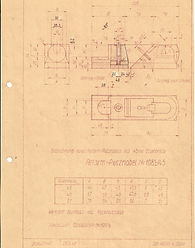Weiss & Sohn Reformhobel Nr. 108 1/2
The "Reformhobel" is a development of the company Georg Ott from Ulm, better known under the brand name Ulmia.
The underlying patent (then called "Gebrauchsmuster") was granted on 6 January 1894 under the title "Plane with put-on sole and adjustable plate to regulate the opening of the mouth". The success was unbelievable, the model was produced over time by practically all German manufacturers in more or less the same design, the Reformhobel can still be found in almost every workshop.
According to Ott, the ideas for the development of this plane go back to impressions during a study trip in America.



However, the idea of regulating the plane's mouth with the help of an adjustable plate in the plane's sole appeared several decades earlier, at least in Austria.
In 1854, Christian Weiland in Vienna acquired a privilege on "improved adjustable double planes" for a period of two years.
The description of the plane in the adjacent advertisement suggests that the plane's mouth could be adjusted by means of a set screw. The Technical Museum in Vienna owns a copy of this plane; the photo does not show the sole, but an adjusting screw is recognisable.
In 1856 Weiland allowed the privilege to expire, making the design freely usable.
Apparently, the company Weiss & Sohn took up Weiland's idea, because in the "Atlas of Austrian Tools for Woodworkers" 1861 a "double smoothing plane" is depicted according to this construction principle. In the mid-1860s, Johann Horak in Prague also had a "double smoothing plane" with adjustable mouth in his assortment. The illustrations clearly show that two adjusting screws were used. Georg Ott equipped the first models of his Reformhobel with only one adjusting screw on the top, only later a second adjusting screw is added at the front.




This plane model remained in the Weiss & Sohn assortment until at least 1917, probably even until the mid-1920s, in a catalogue of the authorized dealer S. Kauders (ESKA) such a plane by Weiss & Sohn is still depicted in 1924.
It should be mentioned here that the principle of adjusting the plane mouth with the help of a screw set from above through the plane body had already been used by many manufacturers for rebate planes with double iron.
The second essential feature of the Reformhobel was the use of an "american" iron wedge instead of the traditional wooden wedge to fix the iron in the plane body. The first Ulmia models had a wedge that bore a remarkable resemblance to those of Stanley's iron and woodbottom planes. But soon wedges with adjusting screw were used, as they were already known from English infill planes.
Weiss & Sohn reacted to the growing success of the Ulmia Reformhobel with the development of its own patented plane with an iron wedge and a new metal “hand protector”. In the catalogue from 1909, the new series with the catalogue numbers 105 to 109 is presented for the first time. The only model with an adjustable plane mouth in this series, the number 108 1/2, can be called Weiss & Sohn's version of a Reformhobel.




However, this attempt to compete with the Ulmia model does not seem to have been very successful. In the mid-1920s, both the 100 series and the adjustable double smoothing plane No. 4 disappeared from the catalogues of Weiss & Sohn. Only the number 108 1/2 remains, but in the patented Ulmia construction, which many German manufacturers had also taken over.
It was made of steamed pear wood with a sole made of lignum vitae, finely polished and sealed with an airtight protective varnish. The shape of the nose corresponded to the Ulmia model, not the usual Weiss & Sohn shape, only the patented rounding at the rear of the plane body clearly identifies this plane as Weiss & Sohn plane. But there were also planes with the typical Weiss nose shape.
In this form, the model 108 1/2 remained in the range until the end of the company.
The following original drawings of the Reformhobel by Johann Weiss & Sohn are from 1949/50.




Sources
Wolfgang Jordan on the Reformhobel and other planes from Georg Ott
Atlas of Austrian tools for woodworkers
Johann Baptist Weiss, Vienna, 1861
(Link: Austrian National Bank, Austrian Books Online )
Picture galleries
A patented Weiss & Sohn plane No. 108 1/2, as it appears for the first time in a catalog in 1909. The iron wedge is held in place by 2 iron noses, which are embedded on both sides of the plane body.






This No. 107 double plane also comes from the 100 series from 1909, slightly longer than No. 108 1/2






A very nice example of a Weiss & Sohn Reformhobel No. 108 1/2 in the patented Ulmia construction. Steamed pear wood, lignum vitae sole, protective varnish.






This example of a Weiss & Sohn Reformhobel is my user in the workshop. The protective coating was only present in places, so I removed it and oiled the plane. That changed the wood color a lot, but it feels much more natural.






The original from Ulmia! Also used in the workshop. This model also has an adjustment screw on the front.







